Between December 2021 and December 2022, fuel prices have soared to unprecedented levels, placing a heavy burden on consumers and businesses worldwide.
From 2021 to 2022, there were unparalleled increases in fuel prices, heavily impacting people who rely on vehicles for life and work. The finance experts at Moneyzine.com wanted to investigate these increases and how they have differed across the UK. We sought to find which UK regions have seen the greatest increases in fuel prices and which have made the best recovery.
The Rise and Fall of UK Fuel Prices in Each Region

Each UK region has had its own experience of fuel price changes, so we’ve broken down their stories. Here are each of the regions in the UK that we looked at and their experience of fuel price fluctuations, ranked in order of their recovery.
Northern Ireland

Northern Ireland is the birthplace of icons–whether it’s the drinks, the music, or the characters. As such, Northern Ireland has always been a leader when it comes to trends, which, in the case of fuel prices, is both a good and bad thing. On the downside, it saw the highest price hike on average across the UK at 21.23%. But encouragingly, Northern Ireland saw the sharpest recovery, with prices dropping by 13.70%.
County Londonderry saw the harshest increase in fuel prices at 21.78%, thanks mostly to the 26.63% increase in the cost of diesel per litre. This was followed by a decent drop of 13.35%. However, it was County Fermanagh, known for its waterways and Lough Erne, that saw the most improvement. After an increase of 21.20%, County Fermanagh saw a decrease in fuel prices of 14.10%.
Wales
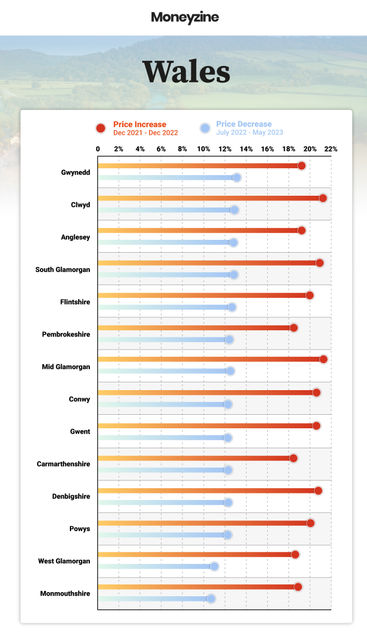
From rugged mountains to rarebit, there’s no denying that Wales is a beautiful and unique area of the UK. Thankfully for the thousands of people who flock there every year to experience the Welsh wilderness, the fuel cost increase in this area wasn’t the worst. Wales experienced one of the more modest price increases, when fuel costs began to climb, of 20%. The Welsh area that saw the highest increase was Mid Glamorgan, with a 21.52% rise. Diesel was the main culprit influencing this, as the fuel saw a price hike of 26.53% in the area.
Despite these price escalations, Wales also saw one of the most substantial recoveries. Fuel prices dropped by a healthy 12.63%. This was even more apparent in Gwynedd, where prices dropped by 13.43%.
North East

From the vast and stunning beauty of its wilderness and coastlines to its proud industrial history, the North East is not a region to be sniffed at. And perhaps thanks to the industrial nature of the region, the North East saw a steady incline in fuel prices, averaging at 19.94%. Tyne and Wear and County Durham saw very similar levels of increase, at 20.33% and 20.28% respectively. Unleaded and super-unleaded had very close increases, of between 16-18%, but diesel really stole the show with cost increases of over 25%.
However, the North East has also made a miraculous recovery. The average price decrease in the region is 12.42%. Both Durham and County Durham have been leading that charge, with their average prices dropping by 12.94% and 12.84% respectively. The North East has seen the biggest fuel cost recovery in England and the third-best recovery across the UK.
Scotland

Moving even further north to Scotland, we find a UK region that has unbeatable scenery and culture. From whisky to haggis, to the mystery of what is worn under a kilt, Scotland has always intrigued the imagination. When it comes to fuel prices, Scotland has fared pretty well when compared to most other areas of the UK. It saw an average price increase of 19.74%, with Banffshire leading the way with a rise of 21.88%. Even unleaded and super-unleaded saw a higher increase than other regions, of between 18-20%.
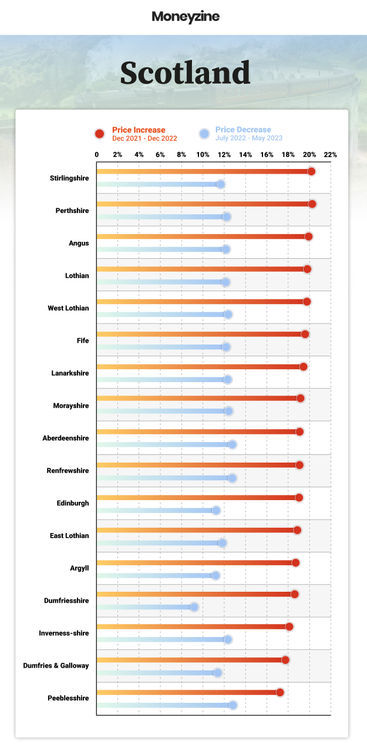
But Scotland has also seen some of the best recoveries from this incredible price hike. Dunbartonshire alone saw a price drop of 14.57%, followed closely by Ross-shire with 14.41%. The cost of unleaded per litre made the strongest comeback, of between 11-16% across the entire region.
North West

From being home to some of the best football teams on the planet to the gorgeous landscapes that are abundant there, the North West is an understated but crucial part of UK culture. Luckily, for the flood of tourists it receives every year, the North West saw the lowest fuel price hike of any UK region, at just 19.47%. This was mostly thanks to Cumbria, which saw the lowest increase of all at 16.95%. Diesel once again saw the biggest hike, still increasing by over 23% in the area.
Despite the great job they did at keeping prices down, the North West hasn’t done so well when it comes to dropping them. Fuel prices have dropped just 11.97% on average across the region, which is one of the lower falls. Cumbria saw one of the weakest recoveries across the UK, with prices dropping by just 9.26%. Greater Manchester saw an awesome recovery in fuel prices, with a decrease of 13.23%.
West Midlands

Serving as the inspiration for many locations in J.R.R. Tolkien’s books, the West Midlands is an often overlooked gem nestled in the heart of the country.
Given the number of people making their own epic quests—whether to the region or just passing through—it's no surprise that fuel prices soared to their highest levels in this area, with an increase of 20.33%. This was especially true in Staffordshire, where costs soared by 20.94%. This was impacted mostly by diesel prices increasing by around 25%, although unleaded and super-unleaded both saw heavy raises of around 16-19%.
However, the West Midlands has made a decent recovery. Prices have dropped by around 11.87% in the area, with Shropshire leading the charge with a decrease of 13.24%.
East of England
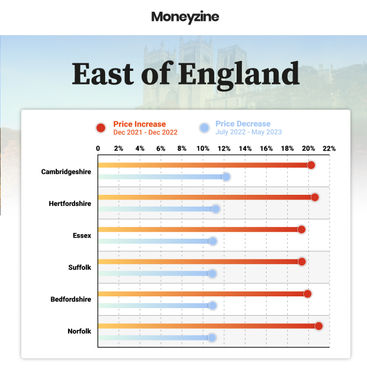
The East of England is known for its wide open spaces of the fens and broads, along with its stunning wildlife and proud aviation history. Given the gas-guzzling nature of planes, it’s less than ideal that fuel prices soared so high in this region. Fuel prices increased by an average of 20.26% across the region with Suffolk being the hardest hit at 20.63%. While diesel prices increased the most at around 25%, unleaded also increased more than many other places. Prices in Norfolk for unleaded reached an increase of 19.42%.
Despite the meteoric rise, the East of England has seen one of the weaker recoveries. Prices for fuel in this region have decreased by just 11.59%. Cambridgeshire saw the strongest recovery, dropping 12.11%. Diesel prices in the area remain high, having lost around just 9% in price.
Yorkshire
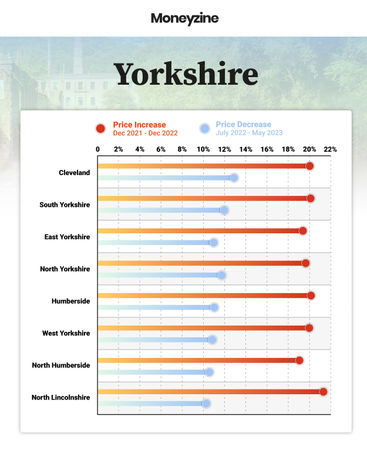
Yorkshire is known for its dales, its moors and its shores—and not to mention its pudding and tea. While it may be a standout icon when it comes to British-ness, when it comes to fuel price increases and recoveries, it’s distinctly in the middle of the pack.
When the fuel prices rose in 2022, Yorkshire followed suit with an average increase of 20.20%. This was particularly apparent in North Lincolnshire, where the average increase was 21.47%. Diesel, in particular, saw a price hike of 26.08%. In fact, North Lincolnshire is the only English region to appear in the top ten for price increases. It is nestled between Mid Glamorgan, which rose by 21.52%, and County Down at 21.45%.
Yorkshire’s fuel price recovery was a similar tale, its averages distinctly, well, average. It had fuel prices drop by 11.56% overall, and North Lincolnshire had the worst recovery. Despite rising the highest, its prices only fell by 10.32%. Compared to Cleveland, which saw a rise of 20.42% and a fall of 13.15%, this seems especially poor.
East Midlands
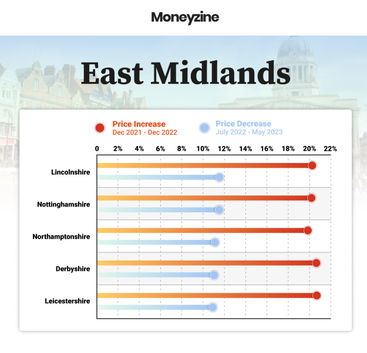
The East Midlands has a strong and proud history, one that often seems to mix myth and legend with fact. Tales of the Sheriff of Nottingham and Sherwood Forest abound. Robin Hood may have stolen from the rich to give to the poor, but the same cannot be said of petrol stations in the East Midlands. Fuel prices in this region rose significantly, just a hair lower than prices in the West Midlands, to 20.32%. Leicestershire and Derbyshire were the worst hit, at a 20.68% and 20.67% rise respectively.
The recovery rate in the East Midlands couldn’t be described as legendary, either. At just 11.42% on average throughout the region, it’s one of the least impactful drops in the UK. Lincolnshire came out the best, with a healthier drop of 11.84% although still not reaching the 12% that other areas did.
South West

The South West of the UK is known for its stunning coastline and natural vistas, as well as a timeless debate on the proper way to eat a scone. The South West is one of the most popular holiday spots in the UK, so it may be surprising how well they fared in the great fuel price hike. This corner of the UK experienced only a moderate increase in fuel prices, of 19.95% on average across the region. North Somerset experienced the greatest increase, at 21.12%, and this was most keenly felt in diesel prices which rose by 26.10%.
The South West also had a disappointing recovery—very close to the East Midlands, the South West saw a price drop of only 11.41%. Wiltshire recovered the most readily, with prices dropping by 11.92% while in Gloucestershire prices only dropped by 10.86%, the worst decrease in the region.
South East

When people think of the South East, their mind often goes straight to London. We wanted to look at the South East and London as two separate entities, as prices can differ so much in and out of the city. We focused instead on the Garden of England and the rolling countryside, rather than the city.
That being said, the South East scored very close to London when it comes to fuel price increases. Prices shot up by 19.84% in the region, most notably in West Sussex where it soared by 20.47%. Unleaded and super-unleaded fuel in the region shot up by between 16 and 18%, while diesel increased by around 25%.
The South East also experienced a disappointing decrease of just 11.32%. Surrey has had the worst recovery in the region however, with a fuel price drop of just 10.74%.
London
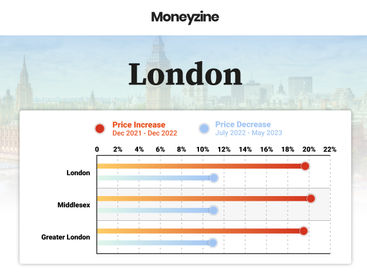
London is the beating heart of the United Kingdom. Known for its thriving culture, bustling crowds, and vibrant history, London is also regarded as the most expensive place in the UK.
It may be surprising, then, that the capital saw a relatively low spike in fuel costs of just 19.87%. While this is still high, it is still a fair way behind some other UK regions. It was Middlesex, rather than London or Greater London, that saw the greatest increase at 20.06%. Super-unleaded saw the least increase of the types of fuels, at around 16%, followed by unleaded (around 17%) and diesel (around 25%).
London also saw a disappointing recovery, with just an 11.06% drop in fuel prices. This was relatively even across all London areas, with London achieving an 11.16% drop, Middlesex at 11.01% and Greater London at 10.99%.
The Regions with the Biggest Increase

Some areas of the UK have been hit harder than others by rising fuel costs, and may have had numerous people thinking about the economics of buying a hybrid car to offset these soaring costs. We’ve ranked the top ten regions that have seen the biggest increase in fuel costs.
Clackmannanshire, Scotland
The dubious honour of first place on the biggest fuel price increases goes to Clackmannanshire in Scotland. Known for its stunning and wild beauty, this scenic haven has had a rough time when it comes to fuel prices. Prices in this region rose by a hefty 22.13%. This is thanks in part to the soaring cost of diesel, which increased by 26.27%.
Banffshire, Scotland
Scotland is having a tricky time in this ranking, and Banffshire is coming in second place to prove it. Recognisable by its rocky coastlines and access to the wild North Sea, Banffshire is a keen destination for nature lovers but not petrolheads. Prices for fuel in the region shot up by 21.88%.
Ross-shire, Scotland
Rounding out the top three highest fuel price hikes is Ross-shire, also in Scotland. This stunning county in the Scottish highlands is known for its complicated history, numerous lochs, and lofty peaks. Following closely behind Banffshire, residents of Ross-shire saw their fuel prices increase by 21.85%.
County Londonderry, Northern Ireland
Finally leaving Scotland, in fourth place is County Londonderry in Northern Ireland. Known for the stunning River Foyle and Derry’s iconic walls, Northern Ireland's second-largest city experienced a hefty fuel price rise. The county saw an increase of 21.78%.
Tayside, Scotland
In fifth place, we return once more to Scotland, to iconic Tayside. Named for the river Tay, this large country encompasses Angus, Dundee, Perth and Kinross. The region experienced a fuel price increase of 21.68%. While the increase in diesel cost was comparatively low, at 25.48%, the area saw a relatively high increase in the cost of super unleaded at 20.75%.
Mid-Glamorgan, Wales
Moving to Wales for the first and last time in this ranking, in sixth place we have Mid Glamorgan. An area of outstanding natural beauty, as well as a place rich in industrial history, Mid Glamorgan has had a tough time with fuel prices. Costs have soared by 21.52%, the most of anywhere in Wales.
North Lincolnshire, England
Arriving in England for the first time, seventh place in the ranking belongs to North Lincolnshire. Famous for its farmland and industrial history, this English county saw a hefty increase in fuel costs. Prices rose by 21.47%, higher than anywhere else in England.
County Down, Northern Ireland
In eighth place, we return once more to Northern Ireland. Home to some of Belfast and all of Bangor, County Down is known for its gorgeous coastlines and the famous Mourne Mountains. The stunning region has seen fuel price increases of 21.45%, with all fuels significantly increasing. Diesel rose by 26.02%, unleaded by 18.99%, and super-unleaded by 19.33%.
Antrim, Northern Ireland
Northern Ireland has done better than Scotland in terms of how high fuel prices have risen, but not in terms of how many regions were affected. Ninth place goes to Antrim, which saw a fuel cost increase of 21.37%. Diesel alone rose by 26.28%.
County Fermanagh, Northern Ireland
Finally, the tenth place goes to County Fermanagh in Northern Ireland. Known for its wild and expansive forests and limestone caves, this Northern Irish county has been hit hard by fuel cost increases. The region saw prices rise by 21.20%, with super unleaded rising by an unusual 20.40%.
The Regions with the Best Fuel Price Recovery
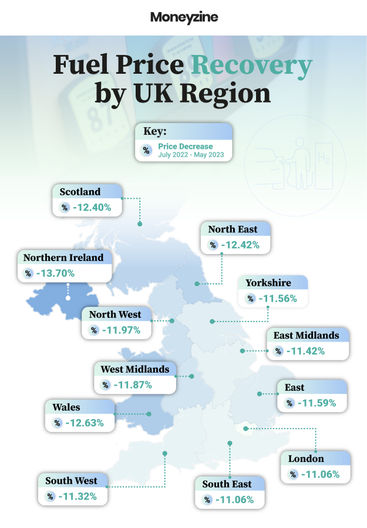
Dunbartonshire, Scotland
Scotland was hit hard by the fuel price increase, with Dunbartonshire just missing out on the top ten highest price hikes. But Dunbartonshire made a great recovery, with fuel prices dropping by 14.57% in the following months.
Ross-shire, Scotland
Ross-shire came third in the price-hike rankings but made a stellar recovery following the high climb. Fuel prices dropped by 14.41% in the county, giving it the second-best recovery in the rankings. Prices in Ross-shire have fallen to an average of 158.48 per litre.
County Fermanagh, Northern Ireland
County Fermanagh came tenth when it came to prices of fuel rising but lands in third place in regards to the price recovery. Fuel prices in County Fermanagh have dropped by an impressive 14.10%.
Armagh, Northern Ireland
Armagh in Northern Ireland also came close to being in the top ten but fell short with an increase of 20.75%. Nevertheless, the region made a strong recovery and saw fuel prices decrease by 14.70%.
Antrim, Northern Ireland
Antrim appeared in ninth place in our price hike rankings, making it one of the best of a bad bunch. But it made a great recovery, landing in fifth place on the recovery list. Fuel prices in Antrim saw a decrease of 13.63%.
County Tyrone, Northern Ireland
County Tyrone in Northern Ireland also saw a significant price hike of 20.78%, though it didn’t make the top ten. It has still seen prices drop significantly, by 13.58% leaving an average fuel cost of 155.09 per litre.
County Down, Northern Ireland
County Down is our final Northern Ireland region, which saw a price recovery drop of 13.47%. This was much needed, as it landed in eighth place for price hikes, with a spike of 21.45%.
Gwynedd, Wales
Our final three entries on the price recovery come from sunny Wales, and the first of them is Gwynedd in eighth place. Saw a moderate increase in prices, but a great drop of 13.43%. Average fuel prices in the region came down to around 156.01 per litre.
Clwyd, Wales
In ninth place is Clwyd in Wales. Clwyd has seen very similar rises and falls to Gwynedd, with a higher fuel price increase of 21.09 and a significant drop of 13.42%. Average fuel prices in Clwyd got as low as an average of 157.57 per litre.
Borders, Scotland
Finally, in tenth place, is Borders in Scotland. Borders saw a moderate price increase, of just 19.52% but made a super recovery. Fuel prices in the region dipped to around 156.47 per litre, which is a drop of 13.38%.
Why Do Fuel Prices Rise?
Fuel prices are often impacted by the current state of the world and its inhabitants. In recent years and decades, the threat of war and its occurrence have heavily influenced the cost of fuel. Russia’s invasion of Ukraine impacted the fuel supply for much of Europe, resulting in increased fuel costs due to scarcity.
The government can also increase fuel duty, also known as pump charges or fuel tax. This can be done as a fund-raising exercise, as it forms a significant income for the UK government, or to encourage government-endorsed green practices to encourage fuel-efficient car technologies and fuel-efficient cars.
Methodology:
Moneyzine sought to investigate which of the 12 UK regions has so far been the most successful in recovering average fuel prices in 2023, following a sharp rise in costs in 2022.
For every county analysed, FleetNews.co.uk was scraped for fuel prices in all months across Diesel, Unleaded and Super-Unleaded PPL (pence per litre), from May 2023-Dec 2021 (Data for Feb 2022 was unavailable and therefore not included in the dataset).
The average of Dec 2021, Jan 2022, March 2022 was compared to the average of Dec 2022-July 2022 to find out how much the percentile increase was for Diesel, Unleaded and Super-Unleaded across all counties. These were then averaged to find out overall which region had the highest increase in fuel prices over 2022.
Additionally, the 5-month average over May-Jan 2023 was calculated and compared to Dec 2022-July 2022 to find out which region recovered best from the fuel increase.
Data was collected on 11/05/2023 and is accurate as of then.
Contributors





